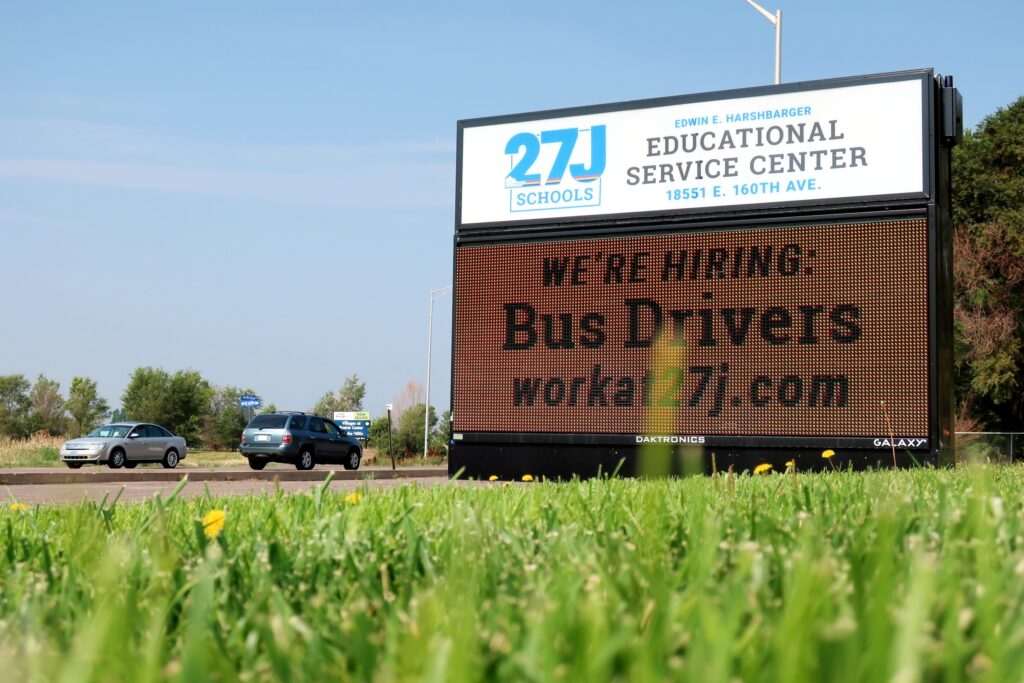
A new report shows the trend toward four-day school weeks in Colorado doesn’t provide a net benefit to the state’s public school students. It also shows the practice might not even be achieving a main goal — boosting teacher recruitment and retention, according to researchers.
More than 60 percent of Colorado’s school districts are on a four-day schedule, but they are mostly small, rural districts. Just 14 percent of the state’s students attend one of these districts.
But some urban districts have switched, with more open to the idea and monitoring whether this experiment is yielding benefits. The state’s low funding of education has forced many districts that were losing educators to higher-paying districts to opt for a four-day week as a way to attract teachers.
“I'm concerned that if that's the reason for why we're doing four day versus five day, that maybe we should be addressing those issues (teacher pay),” said Van Schoales, senior policy director at the Keystone Policy Center, which wrote the report. “And in fact, we think that it's better for kids, let's put forth the evidence for that. We didn't see evidence that it was better for kids.”
The center, which also says budget savings from four-day school weeks are negligible to nonexistent, looks at the impacts on student achievement, teacher talent and enrollment. The report includes interviews with district officials, students and teachers in urban and rural districts, painting a nuanced and mixed portrait of how communities have responded to the four-day week.
Four-day weeks aren’t something district superintendents want
“Colorado is among the leaders in the nation in the four-day week, and I think we should be embarrassed by that,” Philip Qualman, superintendent of Eagle County Schools told the report’s authors. Eagle County continues to have a five-day school week.
He blames the state’s lack of education funding, and not superintendents and school boards, for the situation. Superintendents, particularly in rural areas, said funding is so low, it is impossible to be competitive, according to the report.

Researchers also interviewed supporters of the four-day week such as Jean Schneider, who teaches business classes at Prairie View High School in Brighton. She said it gives educators and students time to attend to other issues in life so that their four days in school are more intentional and focused. Many of her students work to help support their families so the extra day gives them time to bring in income and do homework.
“It really has improved my personal quality of life, which makes me a better professional,” Schneider told the researchers.
Student academic outcomes in four- versus five-day school weeks
School districts in session for five days a week significantly outperform districts with a four-day calendar as measured by state standardized test scores, according to the report.
But the report emphasizes that how well students do academically is heavily correlated with demographics. The gap is largely insignificant for low-income students. This suggests that much of the difference in proficiency rates might be a result of differences in demographics, according to the report.
“But we did find that overall, there were some pretty significant differences,” said Schoales.
The report also looked at academic growth, which shows how much progress individual students have made over a year compared to their "academic peers." The report shows that students in five-day districts are making more progress toward the standards than those in four-day districts. Data show more four-day districts are falling behind their peers.
It concludes that more research needs to be done on how instructional time is used and how school-day-off programs support student learning.
Does a four-day week boost staff recruitment and retention?
The report found some impact but said the shift to a four-day week doesn’t drastically improve staff recruitment and retention.
“Teacher turnover is not meaningfully different based on number of school days and, in many districts, teacher turnover did not improve when they made the shift from five- to four-day calendars despite this being an explicit goal of the shift,” the report states.
Officials in some districts, like 27J, which covers Brighton and surrounding areas, however, believe that the move to a four-day week has had a positive impact on teacher retention.
Stories from the field
The district made the switch in 2018 after voters six times in a row rejected a property tax increase to raise teachers’ salaries. The district has the lowest-funded school district among 15 metro Denver districts.
The report notes that despite having the lowest median teacher salary, $54,900, in the metro area, it had among the lowest teacher turnover rates between 2018-23. However, a 2023 study of 27J by Brown University showed the switch didn’t make a difference for everyone. It found experienced teachers were 5 percentage points less likely to return to 27J after the school district switched to a four-day school week.
“This finding does not necessarily mean that teachers do not value a 4DSW (four-day school week.) Instead, it suggests that the teachers that left 27J were unwilling to trade off the higher salaries offered by outside opportunities for the benefits offered by a 4DSW,” the university report reads.
State statistics show that the neighboring Adams 12 Five Star district, which has a five-day schedule, had an almost identically low turnover rate of 16 percent.
27J’s former superintendent Chris Fiedler, who retired this spring, said the impact on student achievement has been neutral.
What’s happening on that fifth day in 27J?
There are no classes on Mondays but the district offers out-of-school programming at four centers for $35 a day. It only offers programming at four centers because of lower-than-anticipated demand from families. Across the state, the report notes that other districts report a similar phenomenon of families skipping fifth-day programs.
Brighton extended its four days of school to eight-hour days. Families and students have reported appreciating Monday as a rest and catch-up day.
“Mondays have become school- and work-related for us,” Brighton High senior Jaydn Ybarra told Keystone researchers. “If I have a job I can get regularly scheduled on Mondays, or I can use it as a designated homework day. It is a change for the better. I really like the four-day week.”

Southwest Colorado
The motivation of several rural school districts to adopt a four-day school week was to compete with wages in neighboring districts and nearby New Mexico.
In Mancos, superintendent Todd Cordrey has seen no significant difference in student achievement, but the four-day week has helped with teacher recruitment and retention. But he said the five-day week is not grounded in brain science.
“The fact that we really don’t know how learning happens in the brain is critical to this question for knowing what is the appropriate length of time,” he told Keystone researchers. “We know that the formation of the five-day week had nothing to do with student learning and had everything to do with how best to organize a society to make it efficient, and to align with parent work schedules.”
Friday programming in Mancos is popular. It isn’t as popular in the Dolores school district where families rely on extended family to cover child care. Superintendent Reece Blincoe believes on balance the switch to four days has been beneficial for recruitment (new teacher pay is $37,000) but hasn’t helped recover pandemic learning loss. There is no publicly reported data on what is offered for students in Colorado on the fifth day.
Montezuma-Cortez RE-1 originally switched to four days in the early 2000s to save money, which didn’t work. It switched back to five days in 2012 and then back to four days in 2021 after major administrative turnover and teachers leaving for higher-paying districts. Jim Parr, the district’s executive director of student academic services, told researchers that ultimately having a five-day week is better for students.
The region’s largest school district Durango has stuck with a five-day school week. A higher tax base allows the district to pay teachers more than surrounding districts. Superintendent Karen Cheser has been told by colleagues in districts with four-day weeks that educators have to cut corners on activities like field trips and project-based learning.
What does the national research show?
It is difficult to draw clear conclusions about the impact of four-day school weeks. Overall, most studies found that four-day school weeks had a negative impact on student achievement and academic growth, though the degree of impact varied based on a range of factors.
Several small studies suggest that a four-day week can have a positive impact on teacher retention, though other factors can be just as important.
Surveys show students and parents support four-day weeks, with one study showing a decrease in bullying, but another study showed negative impacts on students' health, such as students being more likely to be food insecure and use drugs than five-day school week students.
Studies show different impacts on attendance. Some show a positive impact while another shows it could lead to an increase in chronic absenteeism.

Recommendations
Because the benefits to students aren’t clear, the Keystone Policy Center recommends that the Colorado Department of Education set up a panel to examine four-day school schedules and to make sure all students are getting the support needed to meet state education standards.
The center argues that the decision to have a four-day school week should be driven solely by evidence that it benefits students. It would like to see CDE create a process for state approval of four-day school weeks driven by that central question. Right now, districts ask for a waiver from the state, which appears to be universally approved.
“There hasn’t been a significant public discussion about the benefits of four day versus five day. We think it's important that policymakers and communities really understand what the tradeoffs are,” said Schoales.
In addition, the center recommends a statewide program to raise rural teacher salaries and offer more affordable housing to attract teachers to rural areas.








